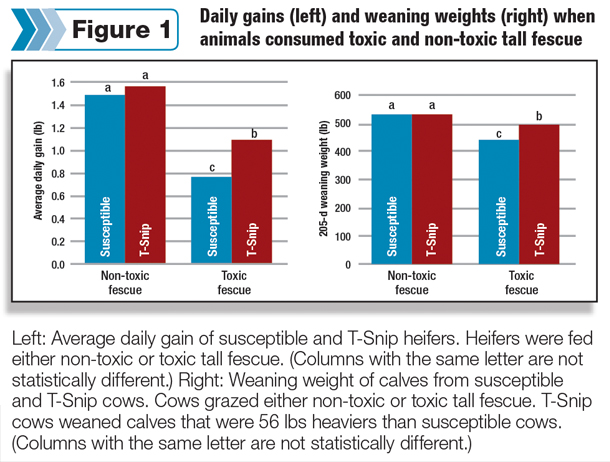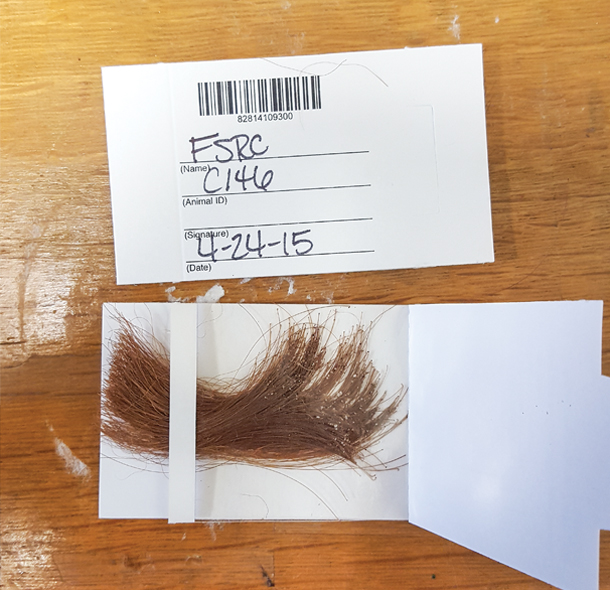AgBotanica LLC, a start-up company founded by industry professionals trained in animal science, plant science and agronomy, has been working on just that – a genetic test that identifies cattle with improved tolerance to fescue toxicosis.
The test, dubbed T-Snip, has been a work in progress for the past seven years and first entered the market in late 2015. It’s the first commercially available genetic test of its kind for cattle exposed to fescue toxicosis.
According to Craig Roberts, a partner for AgBotanica and also a university forage specialist, fescue toxicosis continues to be the most devastating forage-livestock disorder in the eastern U.S., costing the livestock industry $1.8 billion annually.
“Given the seriousness of fescue toxicosis, I really believe that producers in areas where it is prevalent should have their cattle tested,” Roberts says. “We’ve measured this test in eight different herds ranging from about 80 to 650 cattle, and it’s as accurate as any genetic test I’ve seen.”
Improving performance
While no cattle are resistant, Roberts says some animals are more tolerant than others and can help aid producers in their culling and replacement decisions. He says that animals identified as tolerant have an 8 percent increase in dry matter intake, 41 percent increase in gain and 56 pounds heavier weaning weight than susceptible animals.

“If you have a cow that is grazing toxic fescue, her calf will be about 100 to 112 pounds lighter than it should be. But with what we call a ‘T-Snip’ cow, or a cow with improved tolerance, her calf loses about 56 pounds on average; that’s almost exactly half the loss on just one animal,” Roberts explains.
“At least in the cow-calf operations in Missouri, there are many animals losing a lot of money, so to get half of that back is pretty significant.”
There are other options for managing fescue toxicosis. Roberts believes the best option is to replace toxic tall fescue with a variety that contains a novel endophyte. If that option is not feasible, or if replacement is feasible for portions of the acreage, T-Snip testing can be a viable option.
How to test
The current process for T-Snip testing begins by creating an account on the AgBotanica website and ordering sample cards. The samples can then be collected either through a hair or a blood sample.
The AgBotanica website has some instructional videos that show how to collect a hair sample, as it needs more careful instruction than does the collection of a blood sample.

Each hair sample can be collected from the tail switch and must contain the follicle or the root of the hair. At least 25 hairs in total (should be about the size of a small rope) should be included in the sample with the follicle placed in the sticky film of the card. As the samples are collected, the animal’s identification number should be recorded on the card with the client’s name and contact information.
After the $29 payment is made for each animal and the samples are sent to AgBotanica, the samples are then sent to Neogen Corporation, an international food safety company and a developer of animal genomics, where they are tested and then sent back to AgBotanica for scoring.
This process can take anywhere from four to six weeks to complete.
How to interpret and use the data
The T-Snip report presents a score for each animal, ranging from zero = highly susceptible to 5 = improved tolerance. With very few exceptions, animals that score zero to 1 will experience lowest intake and rate of gain, while animals scoring 4 to 5 will have highest intake and rate of gain.
Cows that score 4 to 5 will typically wean calves that weigh from 42 to 69 pounds heavier than cows that score zero to 1.
As of now, there aren’t any recommendations for using the T-Snip score to cull the herd. However, Monty Kerley, a university nutritionist and partner with AgBotanica, says that as with any trait selection, producers should be leery of selecting for one single trait.
“I don’t know of any trait that you would want to single-trait select for,” Kerley says. “The best cow, in terms of the calf she raises, may have some wonderful genetic capability, and if her scores come back low on the test, it doesn’t mean you throw her out.
It just means that there is a lot more reason to make certain that you mate her to sires that are fescue-tolerant.”
Through their trials, Kerley and Roberts have also found that the test can benefit those who are in the process of converting their pasture to novel endophytes – or may have already converted, but their cattle are naïve to fescue toxicosis.
All cattle, including those that scored low for tolerance, probably will experience a sort of “fescue shock” when first arriving in the fescue belt.
One producer’s experience
Mark DeBoo, owner and manager of Diamond D Angus in Valier, Montana, decided to test some of his registered Angus cattle before his annual production sale last year. Although DeBoo doesn’t reside in a region where fescue toxicosis is prevalent, he says he often markets to the areas that are.
“I thought it would be interesting to see the results and potentially help some of my customers in the selection process that do run on fescue,” DeBoo says. “We didn’t advertise specifically about a particular bull or cow, but we did put it in our sale catalog that we could do that – and maybe that’s something we will continue to do in the future.”
DeBoo says that the process wasn’t time-consuming at all. He collected the samples the same time they were running cows through the chute for an ultrasound. It was just a matter of “pulling a few hairs and filling out a form,” he says.
As for this year, DeBoo hasn’t quite made up his mind whether he will test his cattle again. He says it all depends on the cattle market and whether he decides to market to areas where toxic fescue is prevalent.
With that said, however, he believes the test is reliable and can provide some good information to producers in the eastern U.S.
DeBoo points out that the only concern he had with the test is the price, which Kerley and his colleagues recognize might be an issue for most.
“The cost is going to be an issue; I mean, I’m a producer so I can speak with authority that whatever it costs, it should be less,” Kerley quips. “If you look at it, even after how prices have dipped, 50 pounds is worth $75 at $1.50 if you get that much increase weaning weight off the calf and you sell at weaning."
"So if you do this and select heifers with an improved tolerance, you can pay for the test in the first calf. In my opinion, it’s a good return on investment.”
Both Kerley and Roberts point out that they wouldn’t be involved with this test if it didn’t work. Although there are other options for managing fescue toxicosis, this is the only tool on the market that tests genetics, and for producers in the East, this could be a way to recoup at least half of their production loss.
Go to AgBotanica website to learn more.
PHOTO 1: The T-Snip test can identify those animals highly susceptible to fescue toxicosis and those with improved tolerance.
PHOTO 2: Hair samples are taken from the tail switch and placed in the sample card with the animal’s identification number. Photos courtesy of Ryan Lock.








